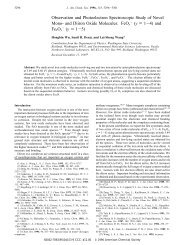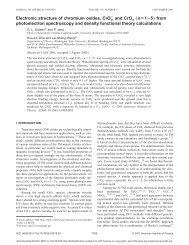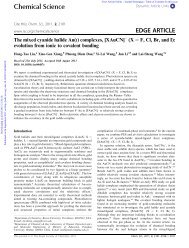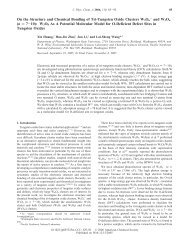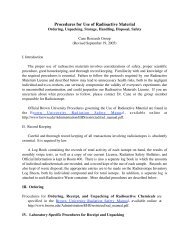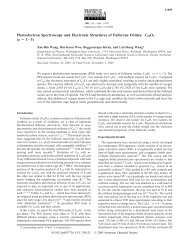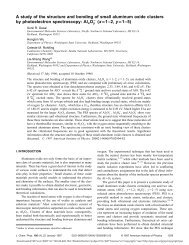Unique CO Chemisorption Properties of Gold Hexamer - Chemistry ...
Unique CO Chemisorption Properties of Gold Hexamer - Chemistry ...
Unique CO Chemisorption Properties of Gold Hexamer - Chemistry ...
Create successful ePaper yourself
Turn your PDF publications into a flip-book with our unique Google optimized e-Paper software.
<strong>Unique</strong> <strong>CO</strong> <strong>Chemisorption</strong> <strong>Properties</strong> <strong>of</strong> <strong>Gold</strong> <strong>Hexamer</strong><br />
ARTICLES<br />
Figure 8. Schematic energy level diagrams <strong>of</strong> Au 6(<strong>CO</strong>) n - (n ) 0-3) based on TD-DFT calculations.<br />
e′ representations. The orbital interaction between the inner and<br />
outer Au 3 fragments leads to the formation <strong>of</strong> a bonding and<br />
antibonding pair <strong>of</strong> a 1 ′ + e′. The six 6s 1 electrons fully occupy<br />
the a 1 ′ + e′ bonding orbitals, giving rise to a (a 1 ′) 2 (e′) 4 (a 1 ′) 0 -<br />
(e′) 0 electron configuration, which is analogous to the delocalized<br />
π electrons in benzene. The antibonding a 1 ′ + e′ orbitals,<br />
which are nearly degenerate, are unoccupied and become the<br />
LUMO and LUMO+1, respectively (Figure 7). This unique<br />
electron configuration and the delocalized nature <strong>of</strong> the a 1 ′ +<br />
e′ orbitals render Au 6 a highly σ-aromatic system, explaining<br />
its special stability and its extremely large HOMO-LUMO gap.<br />
As shown in Figure 6A, the a 1 ′ LUMO <strong>of</strong> Au 6 (the 6a 1 ′ SOMO<br />
in Au - 6 ) is mainly from the outer Au 3 fragment, whereas the e′<br />
LUMO+1 orbitals (8e′) are mainly from the inner Au 3 fragment.<br />
The different spatial distributions <strong>of</strong> these orbitals and their near<br />
degeneracy turn out to be the key in understanding the<br />
interaction <strong>of</strong> Au 6 and <strong>CO</strong>.<br />
5.3. Electronic Structure Evolution and Chemical Bonding<br />
in Au 6 (<strong>CO</strong>) n- . As noted above, there are two major surprising<br />
experimental observations for <strong>CO</strong> interacting with Au - 6 .In<br />
contrast to the smaller gold clusters, chemisorptions <strong>of</strong> <strong>CO</strong> on<br />
Au 6- do not alter significantly the electron binding energies in<br />
the Au 6 (<strong>CO</strong>) - n complexes, whereas the X-A band gap decreases<br />
continuously with increasing <strong>CO</strong> chemisorption (Figure<br />
1). This indicates that the LUMO <strong>of</strong> the neutral Au 6 (<strong>CO</strong>) n<br />
complexes, into which the extra electron occupies in the anions,<br />
is energetically not affected by the <strong>CO</strong> chemisorption, while<br />
the HOMO is pushed up in energy. These observations can be<br />
understood from the above MO analysis for Au 6 and the<br />
schematic MO level diagram depicted in Figure 8. The HOMO<br />
<strong>of</strong> Au 6 is the degenerate 7e′ orbitals (Figure 6A), which involve<br />
strong s-d hybridization and are highly delocalized. The LUMO<br />
<strong>of</strong> Au 6 is 6a 1 ′ (Figure 6A), which is mainly distributed on the<br />
three apex atoms (outer triangle). In the Au - 6 anion the extra<br />
electron enters the 6a 1 ′ orbital and the charge is distributed on<br />
the outer triangle. What is unique to Au 6 is that its LUMO+1<br />
(8e′) (Figure 6A), which is mainly concentrated on the inner<br />
triangle, is very close in energy to the LUMO, as shown in<br />
Figure 8. The consequence <strong>of</strong> this energetic proximity between<br />
the LUMO and LUMO+1 inAu 6 will become clear when <strong>CO</strong><br />
is adsorbed.<br />
When one <strong>CO</strong> is coordinated to an apex atom <strong>of</strong> Au 6 , the<br />
symmetry <strong>of</strong> the molecule is lowered from D 3h to C 2V , and the<br />
degenerate LUMO+1 (8e′)<strong>of</strong>Au 6 is split into a 1 and b 2 orbitals.<br />
The a 1 component <strong>of</strong> the 8e′ orbital strongly mixes with the<br />
6a 1 ′orbital, which are both destabilized (Figure 8). On the other<br />
hand, the b 2 component <strong>of</strong> the 8e′ orbital interacting with the<br />
<strong>CO</strong> 2π orbitals becomes the LUMO, into which the extra<br />
electron enters in Au 6 (<strong>CO</strong>) - . Consequently, the <strong>CO</strong> chemisorption<br />
to Au 6 - induces an internal electron transfer from the outer<br />
triangle to the inner triangle. Since the b 2 LUMO <strong>of</strong> Au 6 <strong>CO</strong><br />
(11b 2 ) does not change much energetically relative to that in<br />
the bare Au 6 species, similar electron binding energies are<br />
expected for the two systems. In Au 6 (<strong>CO</strong>) 2 - and Au 6 (<strong>CO</strong>) 3 - ,<br />
the a 1 component <strong>of</strong> the 8e′ orbital becomes the LUMO, which<br />
is again localized on the inner triangle (Figure 6) and whose<br />
binding energy is not expected to change significantly relative<br />
to that <strong>of</strong> Au 6 - . This situation is unique to the D 3h Au 6 structure,<br />
where there exist two spatially distinct but energetically similar<br />
regions in the molecule. Thus, in the anions, the extra electron<br />
shuttles from the outer triangle to the inner triangle upon<br />
chemisorption, resulting in a relatively constant electron binding<br />
energy for the SOMO in both Au 6 - and Au 6 (<strong>CO</strong>) n - (n ) 1-3)<br />
(Figure 8). In other words, since the extra electron in Au 6 (<strong>CO</strong>) n<br />
-<br />
(n ) 1-3) is localized on the inner Au atoms, it is not sensitive<br />
to the <strong>CO</strong> chemisorption, which only involves the outer Au<br />
atoms. This is also reflected in the similar <strong>CO</strong> binding energies<br />
between the Au 6 (<strong>CO</strong>) n neutrals and the Au 6 (<strong>CO</strong>) n - anions and<br />
their relative independence <strong>of</strong> the <strong>CO</strong> numbers (Table 3).<br />
J. AM. CHEM. SOC. 9 VOL. 127, NO. 34, 2005 12105



